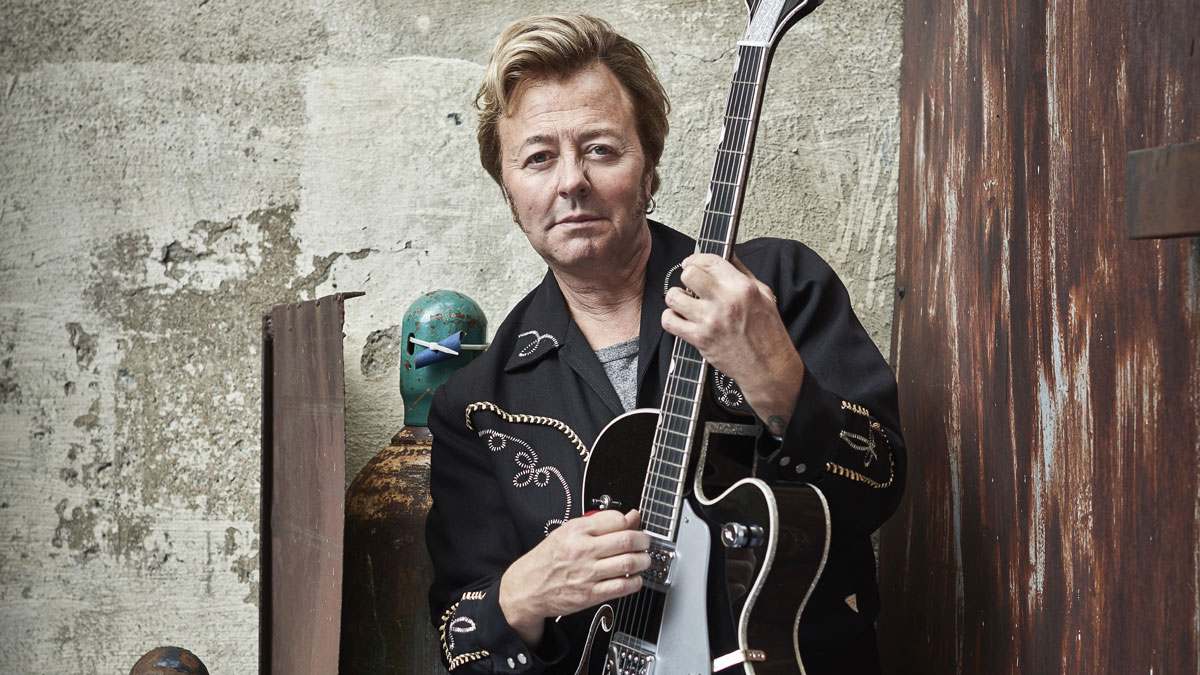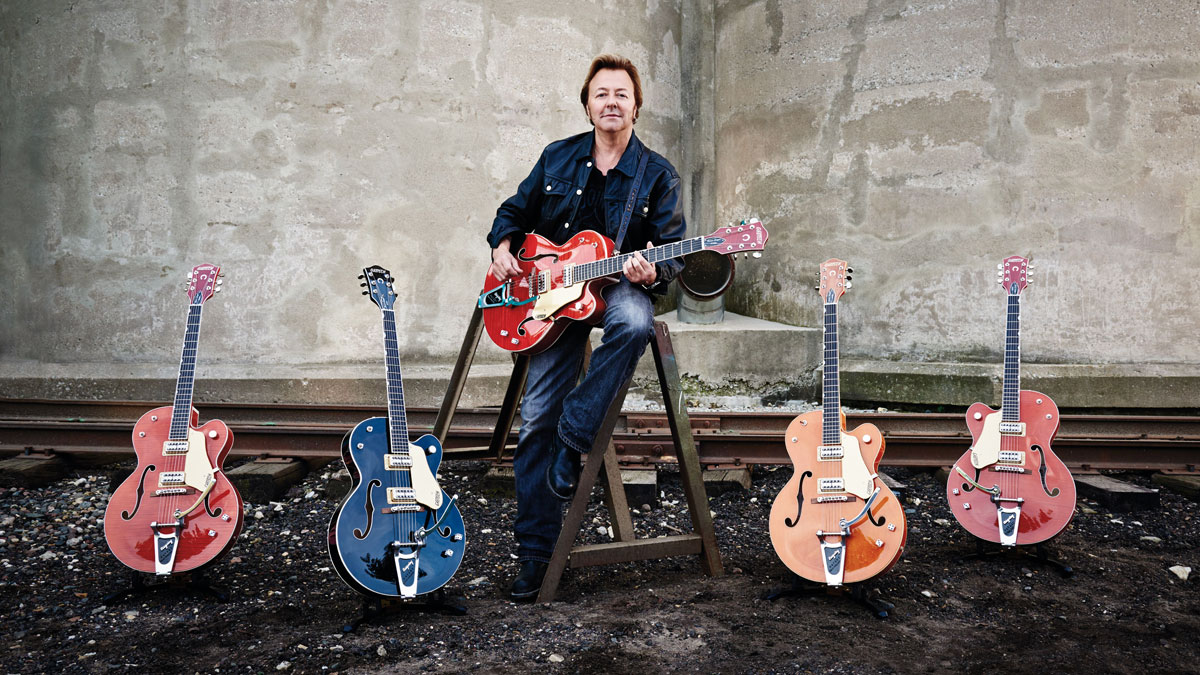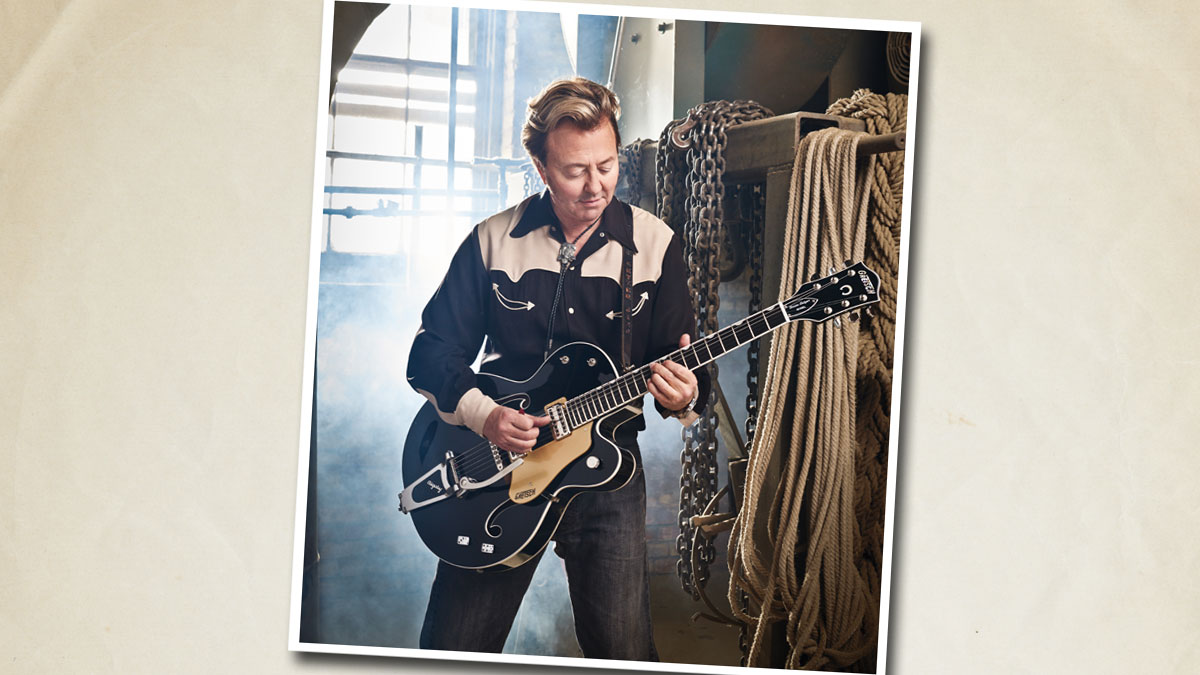Brian Setzer talks Gretsch Hot Rod signature and rockabilly's roots
The Stray Cat's new reason to strut

Introduction
As the rockabilly king, Brian Setzer, unveils his new Hot Rod signature model, he tells us about competing with the drums, his problem with Teles and why great tone is all down to blood, sweat and beer…
Cut Brian Setzer and he bleeds Gretsch. Since he broke cover with The Stray Cats in 1981, the notion of the rockabilly kingpin toting anything else is both unthinkable and unsettling, like Slash wearing a beret or Angus Young hitting the stage in a pinstripe suit.
This year, he unveils a new Hot Rod model with updates that are more than skin-deep
“I don’t feel comfortable with any other guitar,” says the 56-year-old, shaking his bequiffed head. “I just don’t. I’ve pretty much gotten rid of anything that’s not a Gretsch.”
Not only Gretsch’s greatest living brand ambassador, Setzer has long been a keen collaborator on a volley of signature guitars, mostly based on the ’59 6120 that drove early hits such as Stray Cat Strut and Rock This Town. This year, he unveils a new Hot Rod model with updates that are more than skin-deep.
“Gretsch came after me,” he remembers, “and said, ‘We want to do something to continue the Hot Rod line.’ And so I said, ‘Well, we need to do a little more than just slap a coat of paint on it.’ I really wanted to think this out. Because it’s a big deal. You always want them to be absolutely perfect…”

Gretsch's new golden age
Did it take a lot of prototypes to nail the Hot Rod?
“I did go through a couple, because archtops are notoriously more difficult to create than solidbody guitars. You have a top that’s arched, and so it has to be made, whereas a solidbody goes through a jig, y’know? I remember, one prototype came back where I was like, ‘Nah, I don’t care for this fretwork.’ But for the most part, Gretsch now really have it down. They didn’t always. I went back and forth with them on the trestle bracing for years, y’know, 15 years ago, when they were first becoming marketable again. Now, they have it together. The Custom Shop is ridiculous, with Steve Stern over there. I think it’s like the second golden age of Gretsch.”
What are the defining spec changes?
The main upgrade, I think, is the TV Jones pickups that he came up with for me
“First of all, I wanted to get the body a little deeper [70mm], just to get a little more resonance out of the guitar. So we went ahead, we got that done. The main upgrade, I think, is the TV Jones pickups that he came up with for me. What happened was, TV had a guitar [of mine] that he was trading pickups in and out of. So I’d be playing it, and eventually I was like, ‘This one Hot Rod guitar sounds better than the rest - what the hell’s going on?’ And then they told me, ‘Well, we’ve been changing pickups on ya.’ Ah, for crying out loud, y’know? But once I’d gotten those pickups… I mean, TV Jones is a mad scientist. He did a great job with those.”
What do you like about those pickups?
“I think he’s messing with the magnets, using a different kind of material. To me, my God, the original TV Jones pickups sounded great. And these sound just like the originals, but I noticed that when I fingerpicked, I could really get a nice clean sound out. And then, when I dug in with a pick, I could really get a nice overdriven sound. That was the main difference I noticed with these signature pickups - they could go from clean to dirty without touching anything.”
I just fingerpick, and just my skin against the string is enough that it gets it nice and clean
Why do you prefer Filter’Tron-style pickups to Dynasonics or DeArmonds?
“I’ve always gotten the best sound out of them. They’re my favourites, of any of them. These new ones that TV came up with, maybe there’s a little more midrange. All I can tell you is, when I’m playing them, when I fingerpick and I want a clean sound, I don’t have to go to the amp and adjust anything. I just fingerpick, and just my skin against the string is enough that it gets it nice and clean. Because, y’know, I play a lot of jazz chords and fingerpicking style, and you want to hear all that stuff - you don’t want a lot of distortion. But you want a little more edge when you’re getting into a solo.”

Tone time
Tonally, how do the Hot Rods compare to your original ’59 Stray Cats 6120?
“Well, that old Stray Cats guitar had a lot of beer poured in the pickups, a lotta sweat. It probably doesn’t sound the way it sounded 35 years ago. That’s a real bar guitar: it’s gotten used. But if you’re gonna compare it to the way it used to sound on a record or something, then it’s pretty hard to compare. Because that’s pretty much the one I was chasing, y’know?”
You’ve also chosen a pinned bridge: what’s the appeal?
The guitar, it should replicate a violin or a double bass, y’know, where the neck is an extreme curve
“In the early days, I’d always tape ’em down or screw ’em down, because that’s what I had to do, just to get through the gig. And now, they’ve gotten it down to the fine art of having a pin in there where they hold them stable. Y’know, they stay in place, but they move around enough so you can intonate them and get the strings on and off.”
The fingerboard has a 9.5-inch radius, compared to the usual 12…
“Boy, I’ll tell you what: really, I’m a player, and there are a lot of people who are more educated than I am with radiuses. But they measured my original Stray Cat Gretsch and that’s what they got off the neck. So that leads me to believe that back in the 50s, they weren’t as particular as you’d think. I’ve played 12-inch radiuses, and with the 9.5, it’s very subtle, but to me, with a rounder neck, you’re getting a better chord frame. You can chord more easily, and yet you can still bend the strings.
“To me, the guitar, it should replicate a violin or a double bass, y’know, where the neck is an extreme curve. So I kinda like it with a little more of a curve in it than a 12. The 12 is a little flat.”

Hot Rod heaven
How important was it that the Hot Rod looked cool?
“I wanted it to look really rock ’n’ roll. So I thought, y’know, ‘Let’s get rid of the pickguard.’ I don’t know that anybody really scratches the paint on their guitar. I think it’s more decorative, and for me, I can’t get my fingers underneath with that pickguard in the way. The finishes came out of a ’57 Chevy catalogue. I like the colours from that year, so I thought, ‘Whoa, why don’t we use those, rather than just orange?’ But on a car, it’s a solid finish. I thought it’d be cool if we got tinted colours that showed the maple through.”
How does the Hot Rod’s target market differ to your Nashville model?
I think the Hot Rod is more, y’know, you plug the thing straight in, get your band onstage and get going with it
“Y’know, I haven’t aimed them at anyone in particular. I think the Hot Rod is more, y’know, you plug the thing straight in, get your band onstage and get going with it. These guitars, you gotta play ’em. They come off the line, and a big part of it is to get out there and play the thing. You gotta wear it in, y’know? I think the Nashville maybe could be more for a guy who wants to sit down and play a little more fingerstyle guitar.”
Most rockabilly players love Teles, too. Would you ever consider one?
“I love the look of old Teles. But for the life of me, I just can’t play ’em. First of all, it’s the maple neck. It just doesn’t feel finished to me, like, ‘Where’s the fingerboard? You didn’t finish it!’ I feel like I’m on an ice-skating rink. And the layout… I’m so used to hitting the toggle switch up and down, whereas I have to take my fingers off the strings and switch it. It takes too much time.”
Do you appreciate other models in the Gretsch line - the White Falcon, perhaps?
“Yeah, I’ve actually played a White Falcon on this tour I just did in the States: the Custom Shop model, and it’s got my pickups in it. People just can’t stop talking about it. They’re saying, ‘What was that guitar? It was unbelievable, the sound on that thing…’”

Got to be Gretsch
Are there certain techniques that should be played on a Gretsch? What do they specialise in?
“Well, for me, there’s something about a hollow-bodied guitar. When I stand in front of an amp, the sound comes out of that amp and it goes back through the guitar. That hollow-bodied sound, it’s got magic about it. I don’t see why you couldn’t use a Gretsch for any kind of music. Even for metal-type music, where you have a very overdriven sound, I mean, it would play fine for that. I don’t see why not. I’d love to hear a guy play a good blues on a hollowbody Gretsch. That could be a really nice tone that someone should do.”
That hollow-bodied sound, it’s got magic about it
Duane Eddy used to stuff his 6120 to stop feedback: has that ever been an issue?
“No, I never had to do that. Y’know, before the ’58s, they didn’t have the trestle bracing, and I would imagine those would feed back. But once they started with that trestle bracing, that eliminated the problem.”
What amps do you think give the best rockabilly tones?
“Y’know, rockabilly is kinda different in everybody’s head. For me, what I need is - let’s call it ‘rockabilly plus’. I don’t live in the 50s - I like all that stuff that was created then, and I like the sound, but here’s the thing: you gotta beat the drummer. And Slim Jim [Stray Cats drummer] pounded the crap out of those things. I could never get loud enough to beat him.
“But my Fender Bassman was just enough, y’know? Even though it’s an early-60s model, it had just enough of the great tone, but also the volume. Y’know, they originally came with Oxford speakers. We’d blow ’em out, so the speaker of choice would be the Celestion Vintage 30. I’ve been using those forever.”
What role does delay play in your sound?
“Well, my favourite unit is the Roland Space Echo, the 301, because it’s built like a tank, but it’s still a tape echo. The Echoplexes are just unreliable. I could never get those things to work. They sounded great, but they always broke.”

Rockabilly roots
What is it that impresses you in other rockabilly players?
“I think it’s taking your own spin on the music. It’s great to hear someone play like it’s the 50s, but when you put your own personality into it, that’s when it brings it somewhere else. I love JD McPherson, that’s fantastic stuff. I love Imelda May, and Darrel Higham is a fantastic rockabilly player. There’s a Canadian guy called Paul Pigat: he’s just great. There’s a whole bunch of them. Whereas back in the 80s, when I was playing it, it was the new thing again, so there wasn’t many guys doing it.”
It’s great to hear someone play like it’s the 50s, but when you put your own personality into it, that’s when it brings it somewhere else
In your opinion, who was the original rockabilly player?
“I’d say that if you really want to hear Rockabilly 101, you’ve gotta put on Elvis Presley’s The Sun Sessions. I would say Scotty Moore is the guy.”
Were you pleased with the reaction to last year’s Rockabilly Riot?
“Well, I’ve just finished the States tour, and it was like, the songs I played off that record, like Let’s Shake and Nothing Is A Sure Thing, got the same reaction as old hits like Rock This Town and Rumble In Brighton. Which is fantastic. Because, let’s face it, most people go out and have a smoke or get a beer, like, ‘Oh, he’s playing something from the new album, it’s time to hit the men’s room…’”
What else do you have in the pipeline?
“I’ve just finished a Christmas album called Rockin’ Rudolph. It’s with a big band and it’s really good. Y’know, I haven’t made one in about 10 years, and I thought, ‘Well, how many [Christmas songs] could be left?’ But there’s a ton of them. Like, I hadn’t done Rockin’ Around The Christmas Tree or Here Comes Santa Claus. They’re classic songs that you can take anywhere. You have to have the imagination to make ’em swing. But a good song is a good song.”
The Brian Setzer Orchestra will release Brian’s first Christmas album for 10 years, Rockin’ Rudolph, on 16 October.

